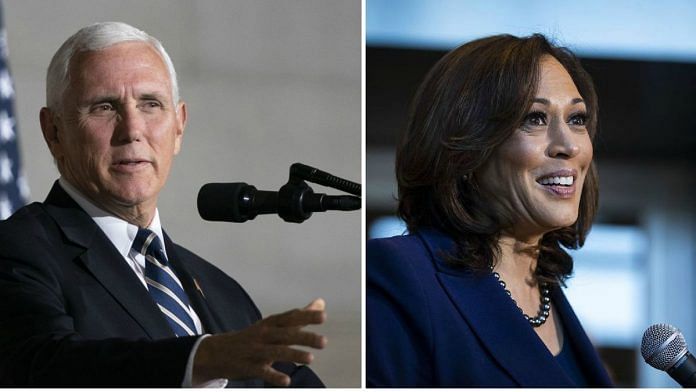New Delhi: US Vice President Michael Pence and Democratic challenger Kamala Harris will face-off in their first and only debate Wednesday (Thursday 6.30 am IST) at Salt Lake City, Utah. It will be the first time in US history that an American of Indian-origin will step up to the podium for a vice-presidential debate.
This face-off is expected to grab eyeballs in a similar way that two previously televised vice-presidential debates had done when woman candidates were in the running — between George H.W. Bush and Geraldine Ferraro in 1984, and between Sarah Palin and Joe Biden in 2008.
Biden went on to become the 47th vice president of the US, under Barack Obama, and is running for President this year. But becoming a presidential nominee isn’t something out of the ordinary for former vice presidents.
At a virtual press briefing earlier this week, Joel K. Goldstein, professor at the Saint Louis University School of Law, had explained how the vice presidency in America is often seen as a “springboard to the presidency”.
Given Biden’s age (77 years) and his comment about being a “bridge” to the next generation of leaders, there is speculation that Harris could be next in line for the presidential race in 2024. Shortly after her nomination, Trump had also acknowledged this possibility by saying, “She can never be the first woman president of the US. It will be an insult to our country.”
Not surprisingly, 17 of the 48 vice presidents in American history have attempted to run for the presidency. But they haven’t always won; only a few like John Adams, Thomas Jefferson, Richard Nixon and George H.W. Bush went on to become presidents by winning an election.
The vice president is supposed to succeeded when an acting president is removed from office, dies or resigns. The most famous, and unique, example of this was the presidency of Gerald Ford, which began in 1974. Ford became president following Nixon’s resignation after the Watergate scandal, having become vice president by replacing Nixon’s original running mate, Spiro Agnew, who resigned due to a corruption scandal. Ford is, therefore, the only person in US history to become president without winning a general election for president or vice president.
ThePrint takes a look at how the role of vice president has evolved through American history.
Also read: Trump ‘intends to be ready’ to debate Biden next week but will oppose a mute button
Vice presidents as ‘legislative officers’
A vice president, according to the US Constitution, serves two major roles. First, she/he is the president of the Senate and presides over its daily proceedings. The vice president has no voting power, except to give a tie-breaking vote when the Senate is deliberating on a legislation. Second, she/he stands first in line of presidential succession.
For most of the 19th and early 20th century, however, vice presidency in America was not a politically ambitious office. Vice presidents like Adams, who served from 1789-1797, and Alben W. Barkley, who was in office from 1949-1953, spent most of their time presiding over the Senate and were viewed mainly as legislative officers, said Goldstein.
The academic also said this had much to do with the fact that vice-presidential nominees were picked by party leaders at the time, unlike today, where the presidential candidate has a say in this decision. This meant that the two candidates (for president and vice president) weren’t always compatible, either personally or politically, “shared no bonds of loyalty”, and often had diverging ideological points of view.
This is perhaps best summed up by former secretary of state Daniel Webster who, in 1848, declined the offer to be Zachary Taylor’s running mate by saying, “I don’t propose to be buried until I’m dead.”
Also read: Vote for America or vote for India-US ties — Why Indian Americans and their funding matter
How Richard Nixon changed the role
The official website of the US Senate describes the American vice presidency as the “least understood, most ridiculed, and most often ignored constitutional office in the federal government”.
But Nixon, who served as the country’s vice president under Dwight D. Eisenhower from 1953 to 1961 before becoming its 37th president in 1969, turned things around.
He began spending less time presiding over the Senate, and more accompanying the war-hero president on assignments and national security meetings, whether in connection with World War II, the Cold War, or social welfare programs like the New Deal.
He started “serving on commissions, liaising with the Congress, and acting as an administration surrogate at home and abroad”. Eisenhower, who was ailing at the time, also made arrangements for Nixon to be fully prepared for the presidential role, should the need arise.
Since then, vice presidents are seen as an integral part of a president’s administration. Richard Bruce Cheney (better known as Dick Cheney), who served as the vice president to George W. Bush, is a prime example. He was seen as taking on a greater role in Bush’s policy development, especially during the ‘war on terror’ in Iraq.
In December 2008, Cheney admitted that he was directly involved in approving interrogation methods used by the CIA, and in the administration of prisons in Cuba’s Guantanamo Bay. He also supported the idea of waterboarding al-Qaeda mastermind Khalid Sheikh Muhammad.
Vice presidential nominees today also play the role of revving up appeal for the presidential candidate. Within two days of Harris being named the Democratic vice-presidential nominee, the Biden campaign and the Democratic National Committee had received $48 million.
Also read: Kamala Harris has a problem before her debate with Vice President Pence – high expectations



